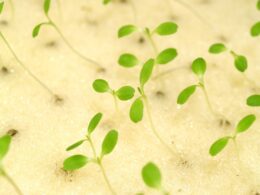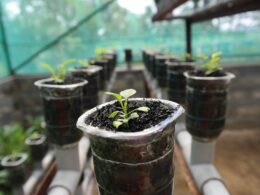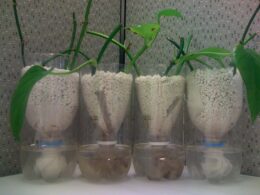Are you interested in hydroponic gardening but unsure of what nutrients to add to your water? Don’t worry, we’ve got you covered.
Hydroponics is a method of growing plants without soil, using nutrient-rich water instead. However, the success of your hydroponic garden heavily depends on the nutrients you add to the water.
To ensure your plants receive the proper nutrients necessary for healthy growth, it’s important to understand the nutrient requirements of your specific plants. This will help you choose the right nutrients to add to your water and mix them correctly.
Additionally, monitoring and adjusting nutrient levels as needed will ensure your plants thrive in their hydroponic environment.
In this article, we’ll walk you through the process of adding nutrients to your hydroponic water for a successful and safe growing experience.
Understand the Nutrient Requirements of Your Plants
Understanding the nutrient requirements of your plants is crucial for achieving optimal growth and ensuring a thriving hydroponic system. When it comes to hydroponics, you must ensure that your plants receive the necessary nutrients that they would typically get from soil, such as nitrogen, phosphorus, and potassium. However, each plant has specific needs that require different levels and ratios of these nutrients.
One essential factor to consider when providing nutrients to your plants is the pH level of the water. The pH level refers to the acidity or alkalinity of the water, and it can affect the plant’s ability to absorb nutrients. Different plants require different pH levels, and it’s crucial to maintain the pH level within the appropriate range for the plant species you’re growing.
Additionally, it’s important to note that plants require different types of nutrients during different stages of their growth cycle. During the vegetative stage, plants require more nitrogen, while during the flowering stage, they require more phosphorus. Understanding the nutrient requirements of your plants at each stage of their growth cycle will help you provide them with the right nutrients at the right time, leading to healthier and more productive plants.
Choose the Right Nutrients
When choosing the right nutrients for your hydroponic plants, you need to consider two key points: macronutrients and micronutrients.
Macronutrients are the major elements that plants need in large quantities, such as nitrogen, phosphorus, and potassium.
Micronutrients, on the other hand, are the minor elements that plants need in smaller quantities, such as iron, zinc, and copper.
Another important factor to consider is whether to use organic or synthetic nutrients.
Organic nutrients are derived from natural sources, while synthetic nutrients are chemically manufactured.
Both types have their own advantages and disadvantages, so it’s important to weigh the pros and cons before making a decision.
Macronutrients and Micronutrients
Proper nutrient balance is essential for healthy plant growth and development in a hydroponic system. Without the right balance of macronutrients and micronutrients, your plants may suffer from nutrient deficiencies, which can stunt their growth and lead to poor yields.
To ensure that your plants receive the nutrients they need, it’s important to understand the difference between macronutrients and micronutrients. Macronutrients are the elements that plants need in large quantities, such as nitrogen, phosphorus, and potassium. These nutrients are crucial for plant growth and development, and deficiencies can cause a range of problems, including stunted growth, yellowing leaves, and poor fruit or flower production.
Micronutrients, on the other hand, are needed in much smaller quantities, but are still essential for healthy plant growth. These include elements such as iron, zinc, and manganese, and deficiencies can also lead to stunted growth and other issues.
To ensure that your plants receive the right balance of macronutrients and micronutrients, it’s important to choose hydroponic solutions that are specifically formulated for your crop, and to monitor the pH balance of your nutrient solution on a regular basis.
Organic vs. Synthetic Nutrients
You might be wondering whether to use organic or synthetic nutrients in your hydroponic system, and it’s important to understand the pros and cons of each. Organic nutrients are derived from natural sources like compost, fish emulsion, and bone meal. They are often touted as being more sustainable and environmentally friendly because they don’t rely on chemicals and are renewable. However, they can be less predictable in terms of nutrient content and can sometimes harbor harmful bacteria if not properly processed.
On the other hand, synthetic nutrients are chemically formulated to provide specific ratios of macronutrients and micronutrients. They are often more consistent in nutrient content and can be tailored to meet the specific needs of your plants. However, they can have a greater environmental impact due to the production and transportation of the chemicals used to create them. It’s important to weigh the pros and cons of both options and consider your personal values when deciding which to use in your hydroponic system.
| Pros of Organic Nutrients | Cons of Organic Nutrients |
|---|---|
| Renewable and sustainable | Less predictable nutrient content |
| Natural sources | Risk of harmful bacteria if not properly processed |
| Pros of Synthetic Nutrients | Cons of Synthetic Nutrients | ||
|---|---|---|---|
| Consistent nutrient content | Greater environmental impact | ||
| Tailored to specific needs | Chemicals used in production and transportation | May not provide the same health benefits as natural nutrients |
Mix the Nutrients Correctly
Make sure you’re mixing the nutrients just right to give your plants the best chance to thrive and reach their full potential. Nutrient ratios are crucial in hydroponics, and it’s important to follow the instructions provided by the manufacturer.
Mixing too much or too little of one nutrient can lead to deficiencies or toxicities, both of which can harm your plants. One of the most common mistakes made when mixing nutrients is not measuring accurately. It’s important to use a precise measuring tool, such as a digital scale or syringe, to ensure you’re adding the correct amount of each nutrient.
Additionally, it’s important to mix the nutrients in the correct order. Start with the base nutrients, then add any supplements or additives. This will ensure that the nutrients are properly dissolved and won’t react negatively with each other. Another important factor to consider when mixing nutrients is pH levels.
Most plants prefer a pH level between 5.5 and 6.5, so it’s important to test the pH of your nutrient solution regularly. If the pH is too high or too low, it can affect the plant’s ability to absorb nutrients. Adjust the pH using pH up or pH down solutions until it’s within the desired range.
By mixing your nutrients correctly and monitoring your pH levels, you can give your plants the best chance to thrive and produce a bountiful harvest.
What are the Necessary Additions to Water for Hydroponics?
When practicing hydroponics, adding nutrients to hydroponic water is essential. These vital additions include a balanced mixture of macronutrients like nitrogen, phosphorus, and potassium, as well as micronutrients such as iron, magnesium, and calcium. Properly nourishing the water solution is crucial for the healthy growth and development of hydroponic plants, ensuring optimal yields and nutrient uptake.
Monitor and Adjust Nutrient Levels
It’s important to keep an eye on your hydroponic nutrient levels and make adjustments as needed. When you first mix your nutrients, make sure you follow the instructions carefully and measure everything accurately. This will ensure that your plants get the right balance of nutrients they need to thrive.
One key factor to monitor is pH balancing. Your plants thrive in a certain pH range, and even a small shift outside of that range can cause problems. Make sure you test your nutrient solution regularly and adjust the pH as needed. You can use pH adjusters to raise or lower the pH level, and there are many products available to help you do this.
Another important consideration is water quality. The quality of your water can impact the nutrient levels in your solution, so it’s important to use clean, filtered water. You may need to test your water for impurities and adjust accordingly.
By keeping a close eye on your nutrient levels, pH balancing, and water quality, you’ll be able to create the ideal growing environment for your hydroponic plants.
Tips for Successful Hydroponic Growing
Get ready to watch your plants flourish as you follow these simple tips for successful hydroponic growing.
To start, make sure you’re monitoring the pH balance of your water consistently. pH levels can greatly impact the nutrient uptake of your plants and can ultimately affect their growth. Keep your pH levels between 5.5 and 6.5 for optimal results.
Next, consider your lighting options. While natural sunlight can work for some hydroponic setups, artificial lighting may be necessary for others. LED lights are a popular choice due to their energy efficiency and flexibility in adjusting the light spectrum. Make sure to position your lights at the correct distance from your plants and adjust their intensity as needed.
Finally, pay attention to the overall health of your plants. Look for signs of nutrient deficiencies, pests, and diseases. Regularly clean your equipment and change out your water to prevent any build-up of harmful bacteria.
With these tips in mind, you’ll be well on your way to a successful hydroponic garden. Happy growing!
Frequently Asked Questions
What is the best type of water to use for hydroponics?
For hydroponics, water quality is key to a successful harvest. The best type of water to use is one that has a stable pH level between 5.5 and 6.5. This ensures that the plants can properly absorb nutrients and grow to their full potential.
It’s important to regularly test the pH level of your water and adjust as necessary with pH up or pH down solutions. Additionally, make sure to use clean, filtered water to avoid any unwanted contaminants that can harm your plants.
By prioritizing water quality and pH stability, you can create an optimal environment for your hydroponic plants to thrive.
How often should I change the nutrient solution in my hydroponic system?
To ensure optimal plant growth in hydroponics, it’s crucial to know how often to change the nutrient solution. This frequency can vary depending on several factors, including the size of your system, the type of plants you’re growing, and the stage of growth.
Generally, it’s recommended to change the nutrient solution every two to three weeks, but you should also keep an eye on the pH and nutrient levels regularly. If you notice any signs of nutrient deficiency or excess (such as yellowing leaves or stunted growth), it may be time to change the solution.
Remember, frequent nutrient changes can be beneficial, but overdoing it can also harm your plants. So, pay close attention to the needs of your plants and adjust accordingly.
Can I use organic nutrients in my hydroponic system?
If you’re considering using organic nutrients in your hydroponic system, you’re joining the organic vs synthetic nutrients debate. Organic nutrients are derived from natural sources, such as compost and animal matter, while synthetic nutrients are artificially made.
One of the pros of using organic nutrients is that they promote a healthier and more natural growth for your plants. They also tend to have a lower risk of overfeeding and causing nutrient burn. However, organic nutrients can be inconsistent in their nutrient levels and may require more frequent monitoring and adjustments.
Ultimately, the decision to use organic or synthetic nutrients in your hydroponic system depends on your personal preferences and goals.
How do I prevent algae growth in my hydroponic system?
To prevent algae growth in your hydroponic system, there are several effective cleaning methods and algae prevention techniques to consider.
One of the easiest ways to prevent algae growth is to keep your hydroponic system clean and well-maintained. This includes regularly cleaning your equipment, removing dead plant matter, and keeping the water temperature at an appropriate level.
You can also use algae inhibitors or UV sterilizers to help prevent algae growth. However, be sure to choose products that are safe for your plants and won’t harm your hydroponic system.
By taking these steps, you can ensure that your hydroponic system remains healthy and free of unwanted algae growth.
What is the ideal pH range for hydroponic nutrient solutions?
Maintaining the ideal pH range is crucial for hydroponic nutrient absorption and overall plant health. The optimal pH range for hydroponic nutrient solutions is between 5.5 and 6.5.
To balance the pH, there are several techniques you can use, such as adding pH adjusters like potassium hydroxide or phosphoric acid. It’s crucial to regularly monitor and adjust the pH levels as fluctuations can lead to nutrient deficiencies or toxicities.
Keeping the pH in check is a key aspect of hydroponic system maintenance, and with the right techniques, you can ensure a safe and healthy growing environment for your plants.
Conclusion
Congratulations! You’ve successfully learned how to add nutrients to your hydroponic water.
Remember that the key to successful hydroponic growing is to understand the nutrient requirements of your plants, choose the right nutrients, mix them correctly, and monitor and adjust nutrient levels.
To achieve the best results, always follow the instructions on the nutrient labels and consider investing in a pH meter and an EC meter to ensure that the nutrient solution is at the right level.
With a little practice and patience, you’ll soon be growing healthy and thriving plants in your hydroponic system.
Happy growing!









